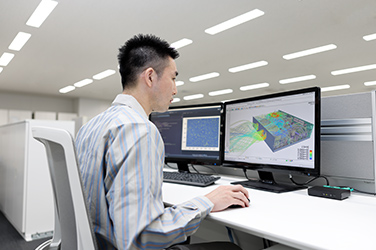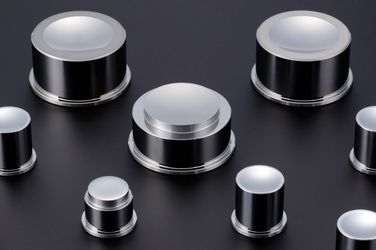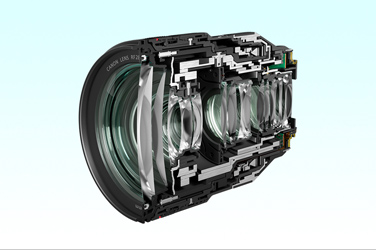
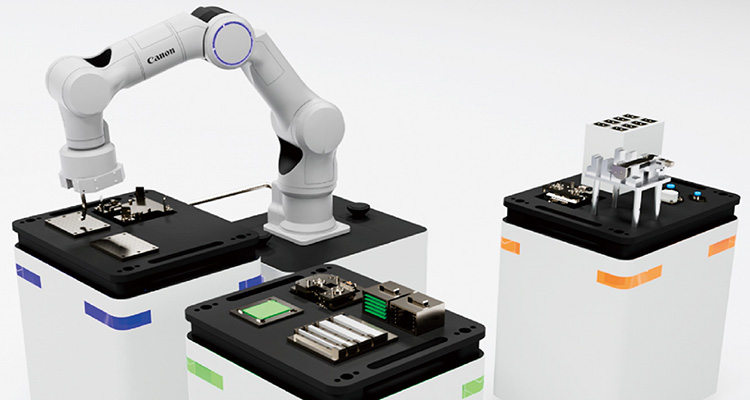
Automation of complex processes and precision assembly opens up new possibilities for products
Automatic assembly technology
Once responsible for only simple assembly, automated assembly has evolved to include delicate and complex assembly processes that require sophisticated skill.
But the purpose of that technology is not replacing people with machines. Automated assembly technology enables rapid and stable precision assembly and even contributes to quality improvement. By linking automated assembly with product design, many of Canon’s businesses aim to reach unexplored territories.
October 16, 2023
Automation of difficult processes that requires sophisticated skil
Delivering attractive products to the world requires a foundation of extremely delicate and highly precise assembly technology. Canon now produces lenses for cameras by automated assembly. Canon has also succeeded in automating exceptionally difficult production processes such as assembling components into tiny space surrounded by delicate and complex structures or inserting components into connectors on electrical boards.
By realizing a system that is constantly in operation to steadily produce high-quality products, Canon goes beyond rationalization to the stage which could not be reached with conventional assembly.

Assembly process of fitting a component into a tight space (plugging a tiny hole with a tiny metal pin)

Part insertion into connector
The automation of these extremely difficult processes is thanks to Canon DNA with which different departments hone each other's skills to create new value. Leveraging internally developed core technologies, all relevant departments, including production technology, product planning and development, work together to solve problems.
For example, Canon developed in-house the robot arm, which is essential for automatic assembly, rather than purchasing existing products.
Canon has also developed simulation software in-house to perform complex processes while synchronizing multiple robotic arms in order to manufacture precise and complex equipment. The production and product development departments work together to flexibly apply robotic arms to a wide variety of products.
In-house development of various core technologies for automated assembly
To automate difficult processes with automated production robots, Canon has been actively taking new ideas and developing them into its own technology.
For example, Canon has achieved precise part alignment with "Visual Servo" applying high-definition and small cameras, that analyzes video information from the camera attached to a robot arm. It performs the process reliably while confirming the precise position with a higher resolution than the human eye.
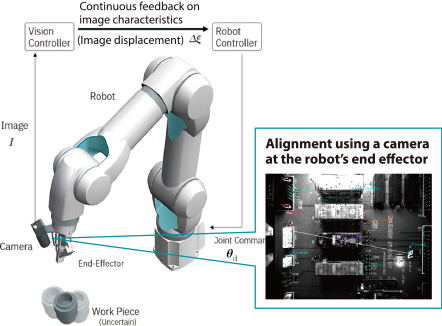

Visual Servo performs precise alignment
Another example is the torque sensitive arm, a technology that uses a computer to control how much force is applied.
By delicately sensing the pressure with the sensor, it allows for quick assembly while exactly executing the specified force magnitude in each of the assembly processes.
In addition, Canon has developed its own simulation software that reproduces robot movements in cyberspace. The proprietary simulation software, which has reflected experience in all the businesses across the company, can design a motion of a robot in just a few tens of minutes. This preparation work to apply the robots in production lines used to take days. This system greatly shortened the time needed.
In addition, the robot's high-precision sensors enable it to achieve the delicate movements set in the simulation.

The high effectiveness of combining them has resulted in an automated production robot called a "multi-skilled automated assembly machine.“
Moving multiple robotic arms at the same time, the machine executes complex parts assembly processes while accurately picking up parts of various shapes and properties from the randomly stacked pile of parts.
The creation of the automated production robot that can work quickly, reliably, and stably, regardless of the number of processes or the sensitivity of the work, is the result of accumulation of experiences developing various automated production technologies.
By providing the machine with different process data and parts trays, it can assemble different products in different processes, enabling it to produce multiple products efficiently and with unprecedented precision.
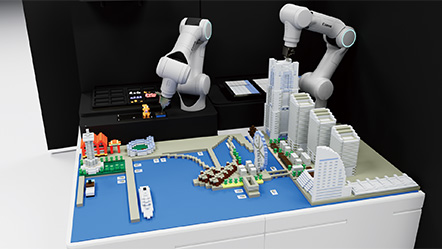
The multi-skilled robot identifies parts of different shapes and properties
A solid foundation of production technology produces cutting-edge products
Canon's automation technology originally started for the production of consumable products including toner cartridges. The technology contributed to customer value in terms of rapid supply and stable quality. Now, Canon's production technology, which was primarily a source of its price competitiveness, has been evolving to become a technology for providing customers with high-quality products, at the same time.
For example, automated assembly greatly increases assembly accuracy to levels that were previously impossible, allowing for complex designs that could not be adopted due to lack of accuracy.
Starting from consumable products such as toner cartridge, in all areas of Canon's business, including consumer products such as cameras, office equipment such as multifunction devices, semiconductor manufacturing equipment, and medical equipment, the product development and production technology divisions have joined forces to realize this evolution, which allows the company to create higher value-added products in each business.
Canon continues to develop a new future by developing technologies to create new values of its products through production technology and deliver them to the customers.


